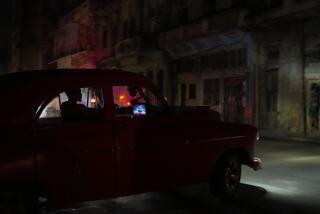LATIN AMERICA : International Power Plays Help Light Up Villages in Cuba
- Share via
MAGDALENA, Cuba — This village in the steamy Sierra Maestra of poor, eastern Cuba lacks paved roads. But it does have street lights, a dozen of them, lining the hamlet’s central dirt path. None of the shanties here has an indoor bathroom. But each boasts the same lawn decoration: a pole with two solar panels and a storage battery.
Along with the dozen solar panels that power the village water pump, the lights and poles are a $35,000 solar-power gift from the government of India.
In the year since the donation, Magdalena has become a laboratory for alternative energy in Cuba. Foreign delegations from conferences--such as a recent alternative energy seminar called Cubasolar--tramp down the steep hill to this village, population 585, about 50 miles west of the county seat at Guama, to see solar power at work.
Store keeper Reinaldo de la Torre, 60, obligingly tells them: “This is marvelous. We are content.”
Too far out in the country for transmission lines to reach, the village once relied on a 25-kilowatt diesel generator.
“It was broken more often than it worked,” recalled Mariolino Enamorado, 64, a barbed wire maker. Even when the generator worked, it could only be run two to four hours a day--to save fuel.
Then, in 1989, the Soviet Union crumbled and oil subsidies to Cuba halted. Often, there was no diesel fuel.
That was when Cuba started getting serious about alternative energy.
Cuba’s sugar industry has employed simple biomass technology for a century, burning sugar cane waste to power mills, said Omar Guerrera, a board member of Cubasolar, a civic group that promotes alternative energy.
But other alternative energy forms got low priority because they were far more expensive than subsidized Soviet oil--until it was no longer available.
With support from the Chinese and Europeans, Cuba has been working since 1984 to complete an ambitious program of small hydroelectric power plants. They are miniature versions of huge operations like Hoover Dam and run best in places that have streams, not rivers, and that need only small amounts of electricity. So far, 206 of them have been built and 184 are running. The other 22 are victims of the pervasive Cuban problem: not enough dollars to buy needed parts.
For example, at La Bruja, on the road to Guama, civil engineers built a 10-foot dam and installed pipes to create a 227-foot drop down to a 30-kilowatt turbine. Slightly larger than a tractor motor, the turbine can generate enough electricity to power the 56 homes at La Bruja, as well as two other nearby villages.
But for three years, the $60,000 project just sat because there was no money for transmission wires, said Guillermo Nilo, an engineer who was in charge of that project and 30 others in the region.
A $30,000 German government donation plugged La Bruja into the turbine in December. The system has drawbacks, such as manual regulation of voltage, which makes for power spikes that burn out light bulbs and wear on appliance motors. But automatic regulators cost money that Cuba does not have.
The government did a feasibility study on hydroelectric power for Magdalena but concluded that a dam could not be built here.
After an alternative energy conference two years ago, the Indian Environmental Ministry proposed the solar panels and offered to provide them if the Cuban government’s Solar Energy Research Center in Santiago would install and maintain them.
The street lights were included. But to the chagrin of Magdalena villagers, so was DC--not AC--power, meaning that the new electrical supply has its limits.
“We have light, but none of my appliances work,” said Dainis Ramos, 22. “They are just there for decoration.”
After the experience in Magdalena, Cuban engineers say they will now design similar projects so the solar panels will feed into transformers and customers will get AC power.
More to Read
Sign up for Essential California
The most important California stories and recommendations in your inbox every morning.
You may occasionally receive promotional content from the Los Angeles Times.













